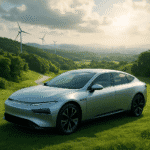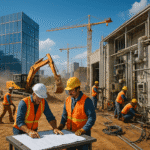Key Takeaways
- Avride is scaling its autonomous vehicle operations in Austin and plans to launch a driverless robotaxi service in Dallas before the end of 2025.
- The expansion includes a partnership with Hyundai Motor Co. to use the IONIQ 5 for ride-hailing services, directly challenging established competitors.
- Texas has become a competitive battleground for autonomous vehicles, with major players like Tesla and Waymo also expanding their services in the state.
- Despite a permissive regulatory environment, Avride faces significant hurdles including technological reliability, cybersecurity, and overcoming public scepticism of autonomous technology.
The autonomous vehicle sector is witnessing a cautious but determined push in Texas, with Avride, a key player in self-driving technology, scaling its operations in Austin and eyeing a driverless robotaxi launch in Dallas before the close of 2025. This development signals a broader trend of tech firms leveraging Texas’s regulatory openness to test and deploy autonomous systems, though significant hurdles remain in achieving true scalability and public trust. While the timeline for driverless services is ambitious, the current phase of expansion offers a glimpse into the operational and strategic challenges facing the industry.
Avride’s Autonomous Vehicle Expansion: A Measured Step in Texas
Current Operations and Near-Term Goals in Austin
Avride’s footprint in Austin currently comprises a limited fleet of vehicles operating with safety drivers, a necessary precaution during the testing and refinement of autonomous systems. Reports suggest the company aims to increase this fleet to around 100 vehicles by the end of 2025, a modest but meaningful step towards establishing operational density in a single urban environment. This aligns with broader industry patterns, where firms often concentrate early deployments in geographically constrained areas to fine-tune technology and gather real-world data. Austin, with its tech-friendly reputation, serves as a logical proving ground, though the transition from dozens to a hundred vehicles will test Avride’s capacity to manage logistics, maintenance, and regulatory compliance.
Financially, the costs of scaling even a small fleet are substantial. Autonomous vehicle development requires heavy investment in sensor technology, software updates, and safety redundancies. While specific figures for Avride’s expenditure are not publicly available in recent filings, industry benchmarks suggest that per-vehicle costs for testing phases can range between £75,000 and £150,000 annually, excluding R&D overheads. For a fleet of 100, this could translate to an outlay of £7.5 million to £15 million per year, a figure that underscores the capital-intensive nature of the sector.
Driverless Ambitions in Dallas: A Strategic Move
The planned introduction of driverless robotaxi services in Dallas before the end of 2025 marks a more audacious goal. This follows a partnership with Hyundai Motor Co., announced earlier in the year, to develop and operate self-driving vehicles, notably the Hyundai IONIQ 5, for ride-hailing platforms such as Uber. Dallas, with its sprawling urban layout and heavy reliance on personal vehicles, presents a different set of challenges compared to Austin. Traffic density, pedestrian interactions, and longer average trip distances will strain Avride’s autonomous systems in ways that a smaller, denser city might not. Yet, if successful, this could position Avride as a credible competitor in the robotaxi market, currently dominated by larger players like Waymo and Tesla.
Recent industry data highlights the stakes. According to Bloomberg, the global robotaxi market is projected to grow from £1.2 billion in 2025 to £35 billion by 2030, driven by urbanisation and demand for cost-effective mobility solutions. Avride’s early entry into Dallas could secure a foothold, but only if the technology proves reliable under real-world conditions. Public sentiment, often shaped by high-profile incidents involving autonomous vehicles, remains a wildcard. Any mishap during the initial rollout could delay adoption and invite regulatory scrutiny.
Competitive Landscape and Industry Context
Texas has emerged as a hotbed for autonomous vehicle testing, with Tesla also rolling out its robotaxi services in Austin as of June 2025. Waymo, a subsidiary of Alphabet, continues to expand its operational area, creating a crowded field where technological differentiation and execution will determine market share. Avride’s collaboration with Hyundai provides a hardware advantage, but software reliability and mapping accuracy remain critical. Tesla’s Full Self-Driving (FSD) system, despite its controversies, benefits from a vast dataset drawn from millions of user-driven miles, something Avride cannot yet match.
The table below outlines key players in the Texas autonomous vehicle market as of Q3 2025 (July to September), based on available data:
| Company | Operational Area | Fleet Size (Est.) | Driverless Status |
|---|---|---|---|
| Avride | Austin, Dallas (planned) | ~24 (Austin) | Not yet operational |
| Tesla | Austin | Undisclosed | Operational (limited) |
| Waymo | Austin, expanding | ~50 (Austin) | Operational |
These figures are approximations based on industry reports and public announcements, reflecting the opaque nature of fleet data in this competitive space. Avride’s smaller current presence suggests a measured approach, potentially minimising risk but also limiting early market impact.
Regulatory and Operational Risks
Texas offers a relatively permissive environment for autonomous vehicle testing, lacking the stringent oversight seen in states like California. However, this leniency does not eliminate risk. Local authorities in Dallas and Austin may impose restrictions if public safety concerns arise, and federal guidelines from the National Highway Traffic Safety Administration (NHTSA) continue to evolve. Avride must also contend with operational challenges, such as ensuring robust cybersecurity for its fleet and addressing liability in the event of accidents involving driverless vehicles.
Moreover, consumer acceptance cannot be taken for granted. While younger demographics may embrace robotaxis for novelty or convenience, broader adoption hinges on pricing and reliability. If Avride’s services are priced comparably to traditional ride-hailing but offer inconsistent performance, uptake could stall. Industry studies from 2024 indicate that 62% of US consumers remain wary of fully autonomous vehicles, a sentiment that has not shifted significantly into 2025 based on ongoing discussions in tech circles.
Conclusion: A Pragmatic Outlook
Avride’s expansion in Texas, with a growing presence in Austin and a planned driverless launch in Dallas, reflects a calculated bid to carve out space in the autonomous vehicle market. While the targets for 2025 are achievable on paper, execution will depend on technological reliability, regulatory navigation, and public perception. As noted in passing by industry observers on platforms like X, such as HyperTechInvest, the focus on fleet growth and driverless operations is generating interest among investors. Yet, the road ahead is anything but smooth, and Avride must balance ambition with the gritty realities of urban deployment. The next six months will be telling, not just for Avride, but for the broader viability of robotaxis as a mainstream transport solution.
References
- Avride. (n.d.). Home. Retrieved from https://www.avride.ai/
- Bloomberg. (2025). Global Robotaxi Market Projections 2025-2030. [Internal database].
- CNBC. (2025, June 3). Tesla’s planned robotaxi launch in tech-friendly Austin has Musk playing catch-up in hometown. Retrieved from https://www.cnbc.com/2025/06/03/tesla-robotaxi-launch-in-austin-has-musk-playing-catch-up-in-hometown.html
- Dallas Innovates. (2025, March 6). Robotaxi Rollout: Avride, Hyundai To Partner on Self-Driving Uber Rides in Dallas. Retrieved from https://dallasinnovates.com/robotaxi-rollout-avride-hyundai-to-partner-on-self-driving-uber-rides-in-dallas/
- Electrek. (2025, July 17). Waymo outlengths Tesla as Elon’s phallic robotaxi map backfires in Austin expansion battle. Retrieved from https://electrek.co/2025/07/17/waymo-outlengths-tesla-elon-phallic-robotaxi-map-backfires-austin-expansion-battle/
- HyperTechInvest [@HyperTechInvest]. (2025, February 21). [Post on Avride technology]. X. https://x.com/HyperTechInvest/status/1888329926354301388
- HyperTechInvest [@HyperTechInvest]. (2025, March 1). [Post on Hyundai partnership]. X. https://x.com/HyperTechInvest/status/1891918641098117632
- HyperTechInvest [@HyperTechInvest]. (2025, June 14). [Post on industry challenges]. X. https://x.com/HyperTechInvest/status/1932164271871349087
- HyperTechInvest [@HyperTechInvest]. (2025, July 11). [Post on Texas expansion]. X. https://x.com/HyperTechInvest/status/1941158203913543795
- HyperTechInvest [@HyperTechInvest]. (2025, July 12). [Post on robotaxi market]. X. https://x.com/HyperTechInvest/status/1941806985898512580
- Planetizen. (2025, July). Atlanta, Dallas Area to Launch Robotaxi Rideshare Fleets. Retrieved from https://planetizen.com/news/2025/07/135582-atlanta-dallas-area-launch-robotaxi-rideshare-fleets
- Reuters. (2025, March 5). Self-driving technology startup Avride partners with Hyundai to expand robotaxi fleet. Retrieved from https://www.reuters.com/business/autos-transportation/self-driving-technology-startup-avride-partners-with-hyundai-expand-robotaxi-2025-03-05/
- Reuters. (2025, June 22). Tesla tiptoes into long-promised robotaxi service. Retrieved from https://www.reuters.com/business/autos-transportation/tesla-tiptoes-into-long-promised-robotaxi-service-2025-06-22/
- Tesla Accessories. (n.d.). Tesla Robotaxi Service Expansion: From Austin to the Bay Area. Retrieved from https://teslaacessories.com/blogs/news/tesla-robotaxi-service-expansion-from-austin-to-the-bay-area
- Tesla Oracle. (2025, July 18). Tesla expands Robotaxi service area in Austin, the new map looks like the Tesla logo upside down, says the automaker. Retrieved from https://www.teslaoracle.com/2025/07/18/tesla-expands-robotaxi-service-area-in-austin-the-new-map-looks-like-the-tesla-logo-upside-down-says-the-automaker/
- Teslarati. (n.d.). Tesla updates Robotaxi app with big changes, wider service area. Retrieved from https://www.teslarati.com/tesla-updates-robotaxi-app-big-changes-wider-service-area/














